Psychology Quiz: Hypothesis Testing, Correlation, and T-Tests
VerifiedAdded on 2022/09/14
|9
|1441
|19
Quiz and Exam
AI Summary
This psychology quiz assesses understanding of key statistical concepts. It covers the distribution of sample means, the steps of hypothesis testing, and the interpretation of alpha levels. Questions explore correlation types, including positive, negative, and zero relationships, as well as the Pearson-r correlation. The quiz also delves into t-tests, including requirements for their use, and the distinction between independent and repeated measures designs. Furthermore, it tests the ability to identify appropriate hypothesis statements (null and alternative, one-tailed and two-tailed), determine critical values, and interpret statistical outcomes, including Type I and Type II errors. The quiz also includes questions on identifying independent and dependent variables and interpreting the results of statistical tests.
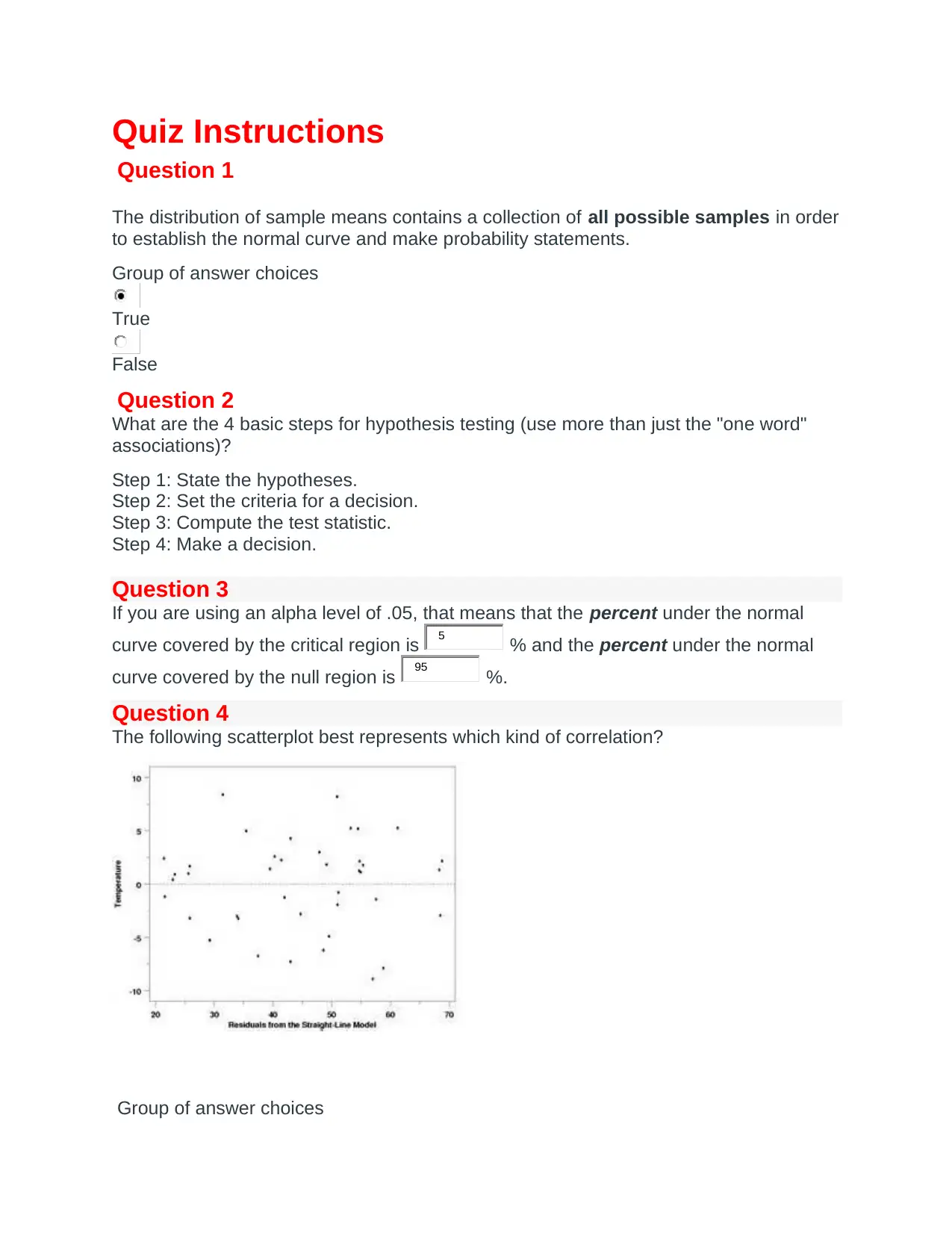
Quiz Instructions
Question 1
The distribution of sample means contains a collection of all possible samples in order
to establish the normal curve and make probability statements.
Group of answer choices
True
False
Question 2
What are the 4 basic steps for hypothesis testing (use more than just the "one word"
associations)?
Step 1: State the hypotheses.
Step 2: Set the criteria for a decision.
Step 3: Compute the test statistic.
Step 4: Make a decision.
Question 3
If you are using an alpha level of .05, that means that the percent under the normal
curve covered by the critical region is 5
% and the percent under the normal
curve covered by the null region is 95
%.
Question 4
The following scatterplot best represents which kind of correlation?
Group of answer choices
Question 1
The distribution of sample means contains a collection of all possible samples in order
to establish the normal curve and make probability statements.
Group of answer choices
True
False
Question 2
What are the 4 basic steps for hypothesis testing (use more than just the "one word"
associations)?
Step 1: State the hypotheses.
Step 2: Set the criteria for a decision.
Step 3: Compute the test statistic.
Step 4: Make a decision.
Question 3
If you are using an alpha level of .05, that means that the percent under the normal
curve covered by the critical region is 5
% and the percent under the normal
curve covered by the null region is 95
%.
Question 4
The following scatterplot best represents which kind of correlation?
Group of answer choices
Paraphrase This Document
Need a fresh take? Get an instant paraphrase of this document with our AI Paraphraser
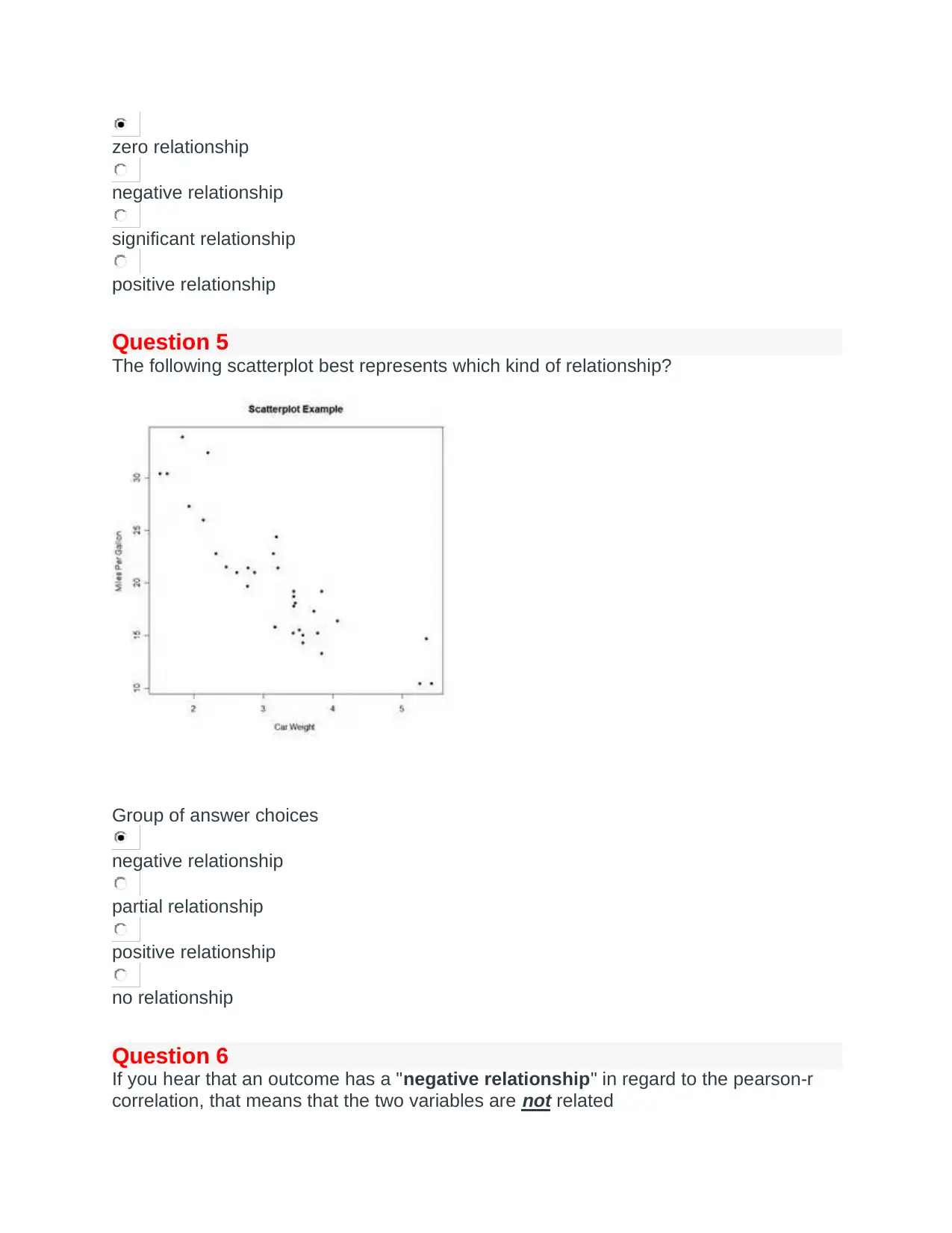
zero relationship
negative relationship
significant relationship
positive relationship
Question 5
The following scatterplot best represents which kind of relationship?
Group of answer choices
negative relationship
partial relationship
positive relationship
no relationship
Question 6
If you hear that an outcome has a "negative relationship" in regard to the pearson-r
correlation, that means that the two variables are not related
negative relationship
significant relationship
positive relationship
Question 5
The following scatterplot best represents which kind of relationship?
Group of answer choices
negative relationship
partial relationship
positive relationship
no relationship
Question 6
If you hear that an outcome has a "negative relationship" in regard to the pearson-r
correlation, that means that the two variables are not related
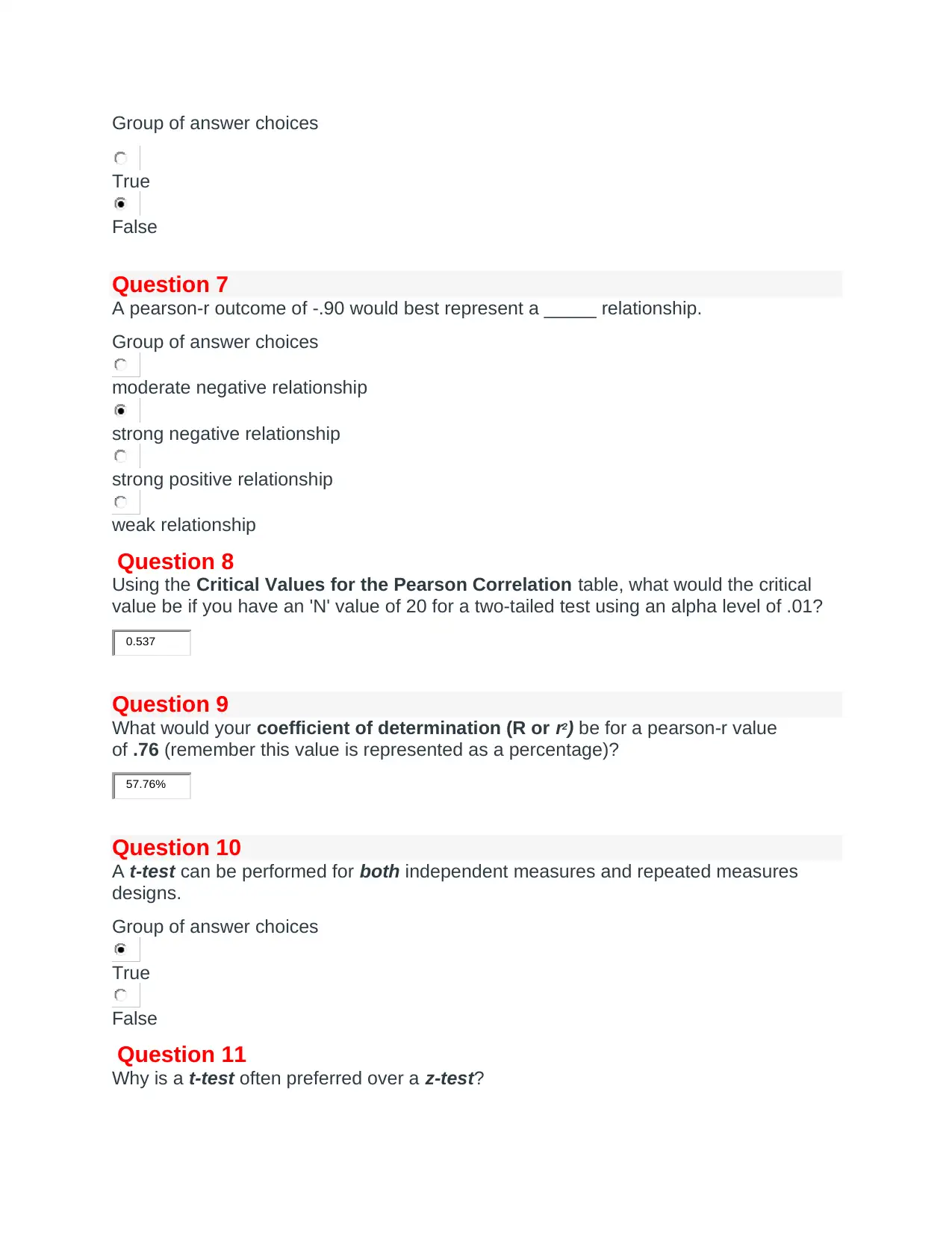
Group of answer choices
True
False
Question 7
A pearson-r outcome of -.90 would best represent a _____ relationship.
Group of answer choices
moderate negative relationship
strong negative relationship
strong positive relationship
weak relationship
Question 8
Using the Critical Values for the Pearson Correlation table, what would the critical
value be if you have an 'N' value of 20 for a two-tailed test using an alpha level of .01?
0.537
Question 9
What would your coefficient of determination (R or r2) be for a pearson-r value
of .76 (remember this value is represented as a percentage)?
57.76%
Question 10
A t-test can be performed for both independent measures and repeated measures
designs.
Group of answer choices
True
False
Question 11
Why is a t-test often preferred over a z-test?
True
False
Question 7
A pearson-r outcome of -.90 would best represent a _____ relationship.
Group of answer choices
moderate negative relationship
strong negative relationship
strong positive relationship
weak relationship
Question 8
Using the Critical Values for the Pearson Correlation table, what would the critical
value be if you have an 'N' value of 20 for a two-tailed test using an alpha level of .01?
0.537
Question 9
What would your coefficient of determination (R or r2) be for a pearson-r value
of .76 (remember this value is represented as a percentage)?
57.76%
Question 10
A t-test can be performed for both independent measures and repeated measures
designs.
Group of answer choices
True
False
Question 11
Why is a t-test often preferred over a z-test?
⊘ This is a preview!⊘
Do you want full access?
Subscribe today to unlock all pages.

Trusted by 1+ million students worldwide
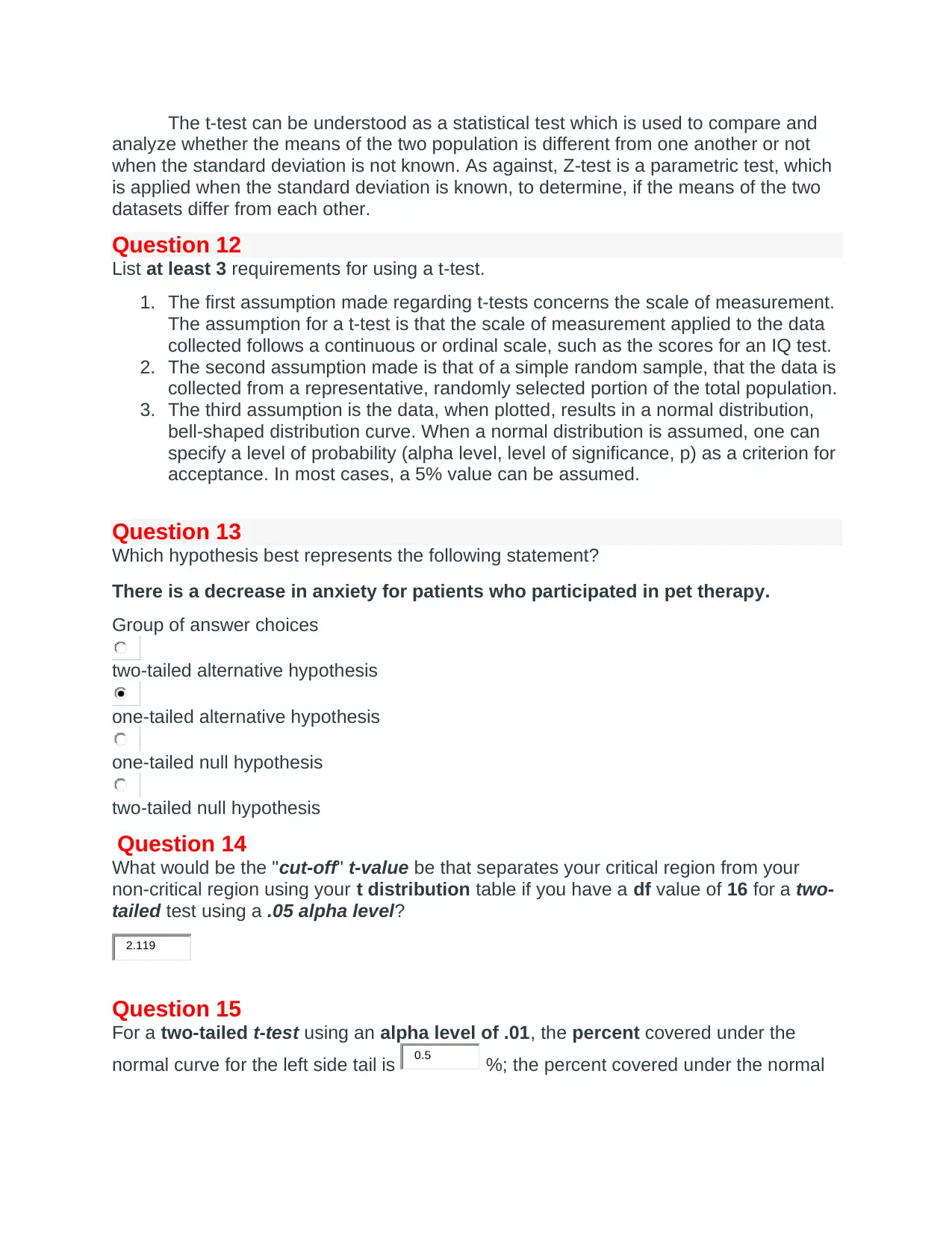
The t-test can be understood as a statistical test which is used to compare and
analyze whether the means of the two population is different from one another or not
when the standard deviation is not known. As against, Z-test is a parametric test, which
is applied when the standard deviation is known, to determine, if the means of the two
datasets differ from each other.
Question 12
List at least 3 requirements for using a t-test.
1. The first assumption made regarding t-tests concerns the scale of measurement.
The assumption for a t-test is that the scale of measurement applied to the data
collected follows a continuous or ordinal scale, such as the scores for an IQ test.
2. The second assumption made is that of a simple random sample, that the data is
collected from a representative, randomly selected portion of the total population.
3. The third assumption is the data, when plotted, results in a normal distribution,
bell-shaped distribution curve. When a normal distribution is assumed, one can
specify a level of probability (alpha level, level of significance, p) as a criterion for
acceptance. In most cases, a 5% value can be assumed.
Question 13
Which hypothesis best represents the following statement?
There is a decrease in anxiety for patients who participated in pet therapy.
Group of answer choices
two-tailed alternative hypothesis
one-tailed alternative hypothesis
one-tailed null hypothesis
two-tailed null hypothesis
Question 14
What would be the "cut-off" t-value be that separates your critical region from your
non-critical region using your t distribution table if you have a df value of 16 for a two-
tailed test using a .05 alpha level?
2.119
Question 15
For a two-tailed t-test using an alpha level of .01, the percent covered under the
normal curve for the left side tail is 0.5
%; the percent covered under the normal
analyze whether the means of the two population is different from one another or not
when the standard deviation is not known. As against, Z-test is a parametric test, which
is applied when the standard deviation is known, to determine, if the means of the two
datasets differ from each other.
Question 12
List at least 3 requirements for using a t-test.
1. The first assumption made regarding t-tests concerns the scale of measurement.
The assumption for a t-test is that the scale of measurement applied to the data
collected follows a continuous or ordinal scale, such as the scores for an IQ test.
2. The second assumption made is that of a simple random sample, that the data is
collected from a representative, randomly selected portion of the total population.
3. The third assumption is the data, when plotted, results in a normal distribution,
bell-shaped distribution curve. When a normal distribution is assumed, one can
specify a level of probability (alpha level, level of significance, p) as a criterion for
acceptance. In most cases, a 5% value can be assumed.
Question 13
Which hypothesis best represents the following statement?
There is a decrease in anxiety for patients who participated in pet therapy.
Group of answer choices
two-tailed alternative hypothesis
one-tailed alternative hypothesis
one-tailed null hypothesis
two-tailed null hypothesis
Question 14
What would be the "cut-off" t-value be that separates your critical region from your
non-critical region using your t distribution table if you have a df value of 16 for a two-
tailed test using a .05 alpha level?
2.119
Question 15
For a two-tailed t-test using an alpha level of .01, the percent covered under the
normal curve for the left side tail is 0.5
%; the percent covered under the normal
Paraphrase This Document
Need a fresh take? Get an instant paraphrase of this document with our AI Paraphraser
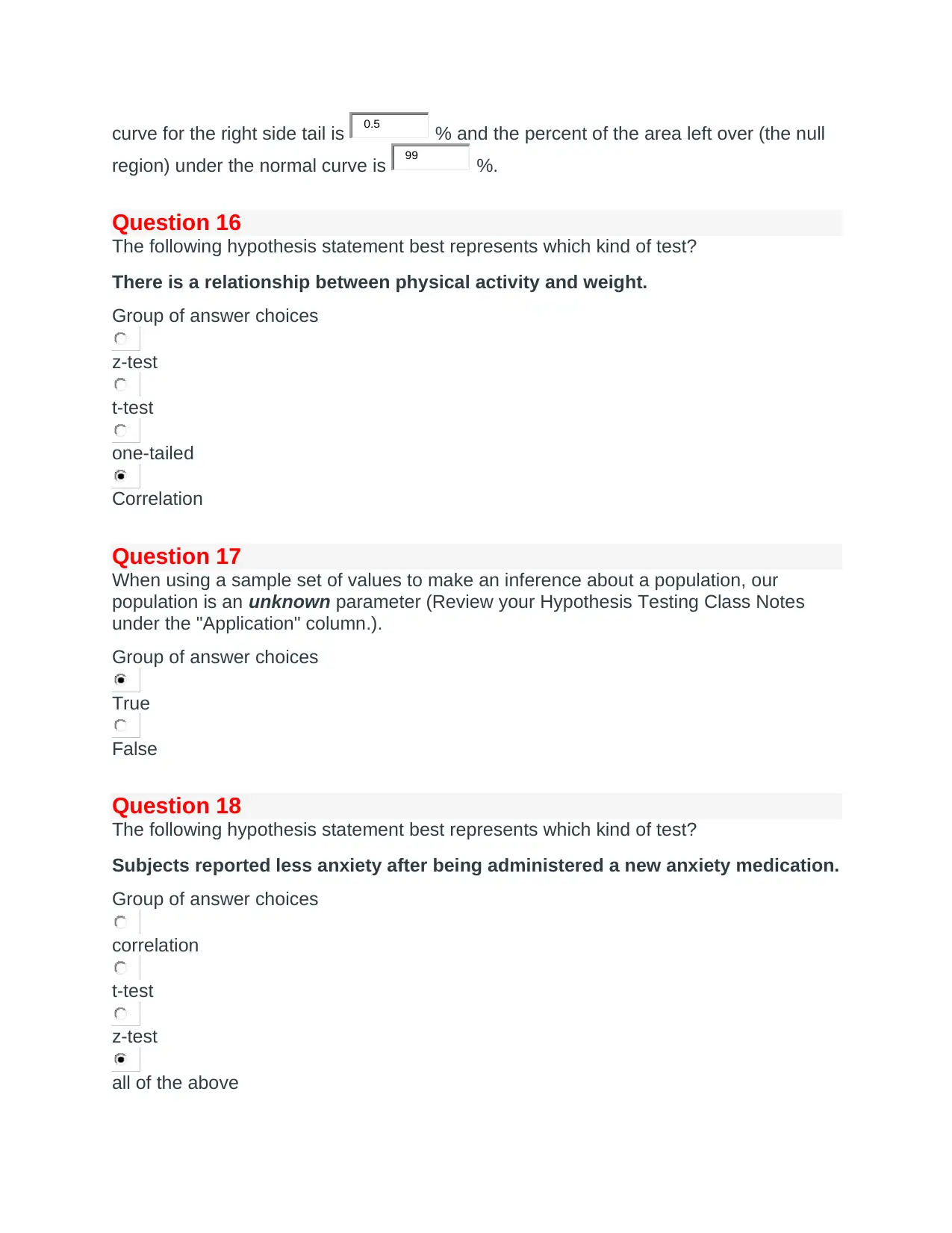
curve for the right side tail is 0.5
% and the percent of the area left over (the null
region) under the normal curve is 99
%.
Question 16
The following hypothesis statement best represents which kind of test?
There is a relationship between physical activity and weight.
Group of answer choices
z-test
t-test
one-tailed
Correlation
Question 17
When using a sample set of values to make an inference about a population, our
population is an unknown parameter (Review your Hypothesis Testing Class Notes
under the "Application" column.).
Group of answer choices
True
False
Question 18
The following hypothesis statement best represents which kind of test?
Subjects reported less anxiety after being administered a new anxiety medication.
Group of answer choices
correlation
t-test
z-test
all of the above
% and the percent of the area left over (the null
region) under the normal curve is 99
%.
Question 16
The following hypothesis statement best represents which kind of test?
There is a relationship between physical activity and weight.
Group of answer choices
z-test
t-test
one-tailed
Correlation
Question 17
When using a sample set of values to make an inference about a population, our
population is an unknown parameter (Review your Hypothesis Testing Class Notes
under the "Application" column.).
Group of answer choices
True
False
Question 18
The following hypothesis statement best represents which kind of test?
Subjects reported less anxiety after being administered a new anxiety medication.
Group of answer choices
correlation
t-test
z-test
all of the above
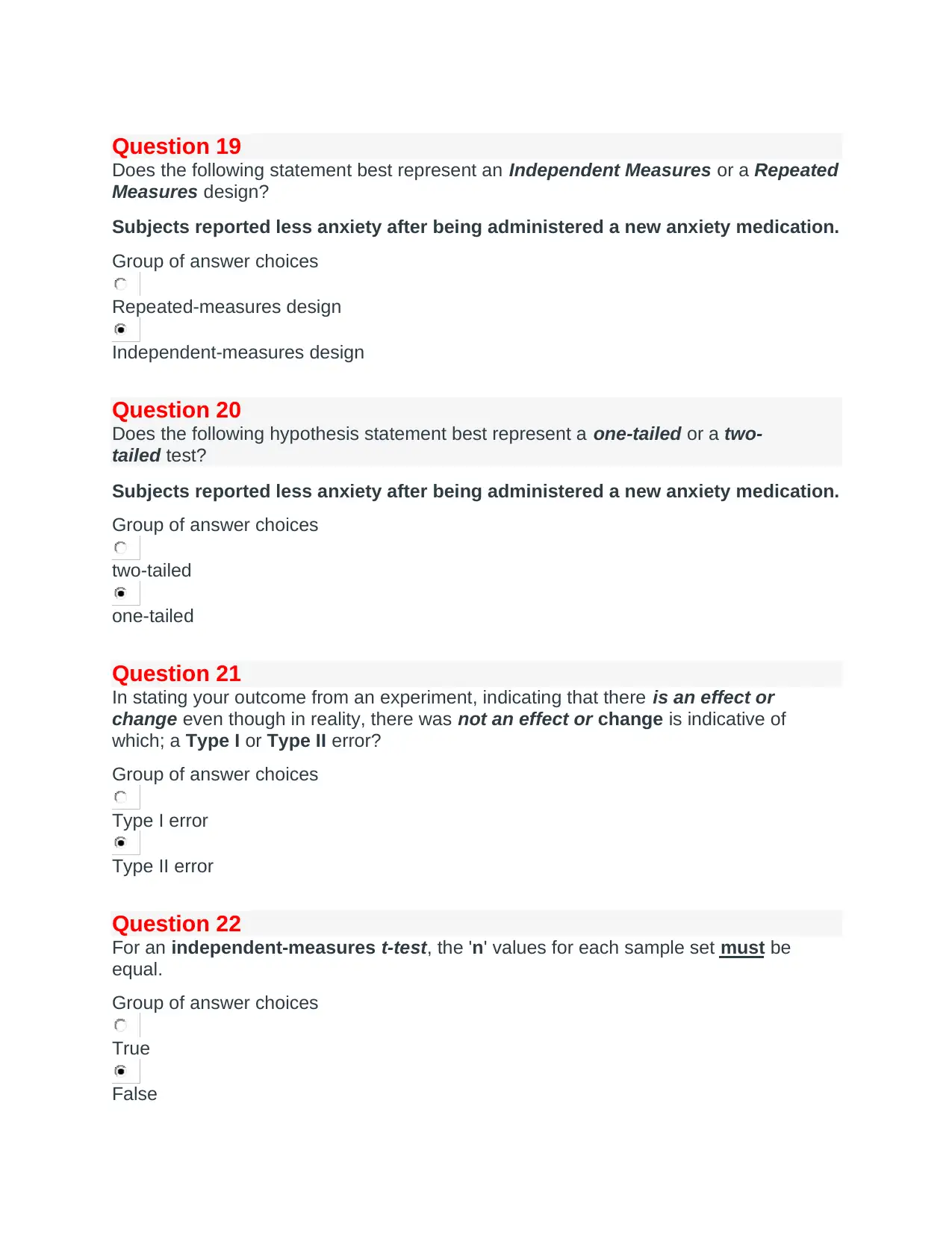
Question 19
Does the following statement best represent an Independent Measures or a Repeated
Measures design?
Subjects reported less anxiety after being administered a new anxiety medication.
Group of answer choices
Repeated-measures design
Independent-measures design
Question 20
Does the following hypothesis statement best represent a one-tailed or a two-
tailed test?
Subjects reported less anxiety after being administered a new anxiety medication.
Group of answer choices
two-tailed
one-tailed
Question 21
In stating your outcome from an experiment, indicating that there is an effect or
change even though in reality, there was not an effect or change is indicative of
which; a Type I or Type II error?
Group of answer choices
Type I error
Type II error
Question 22
For an independent-measures t-test, the 'n' values for each sample set must be
equal.
Group of answer choices
True
False
Does the following statement best represent an Independent Measures or a Repeated
Measures design?
Subjects reported less anxiety after being administered a new anxiety medication.
Group of answer choices
Repeated-measures design
Independent-measures design
Question 20
Does the following hypothesis statement best represent a one-tailed or a two-
tailed test?
Subjects reported less anxiety after being administered a new anxiety medication.
Group of answer choices
two-tailed
one-tailed
Question 21
In stating your outcome from an experiment, indicating that there is an effect or
change even though in reality, there was not an effect or change is indicative of
which; a Type I or Type II error?
Group of answer choices
Type I error
Type II error
Question 22
For an independent-measures t-test, the 'n' values for each sample set must be
equal.
Group of answer choices
True
False
⊘ This is a preview!⊘
Do you want full access?
Subscribe today to unlock all pages.

Trusted by 1+ million students worldwide
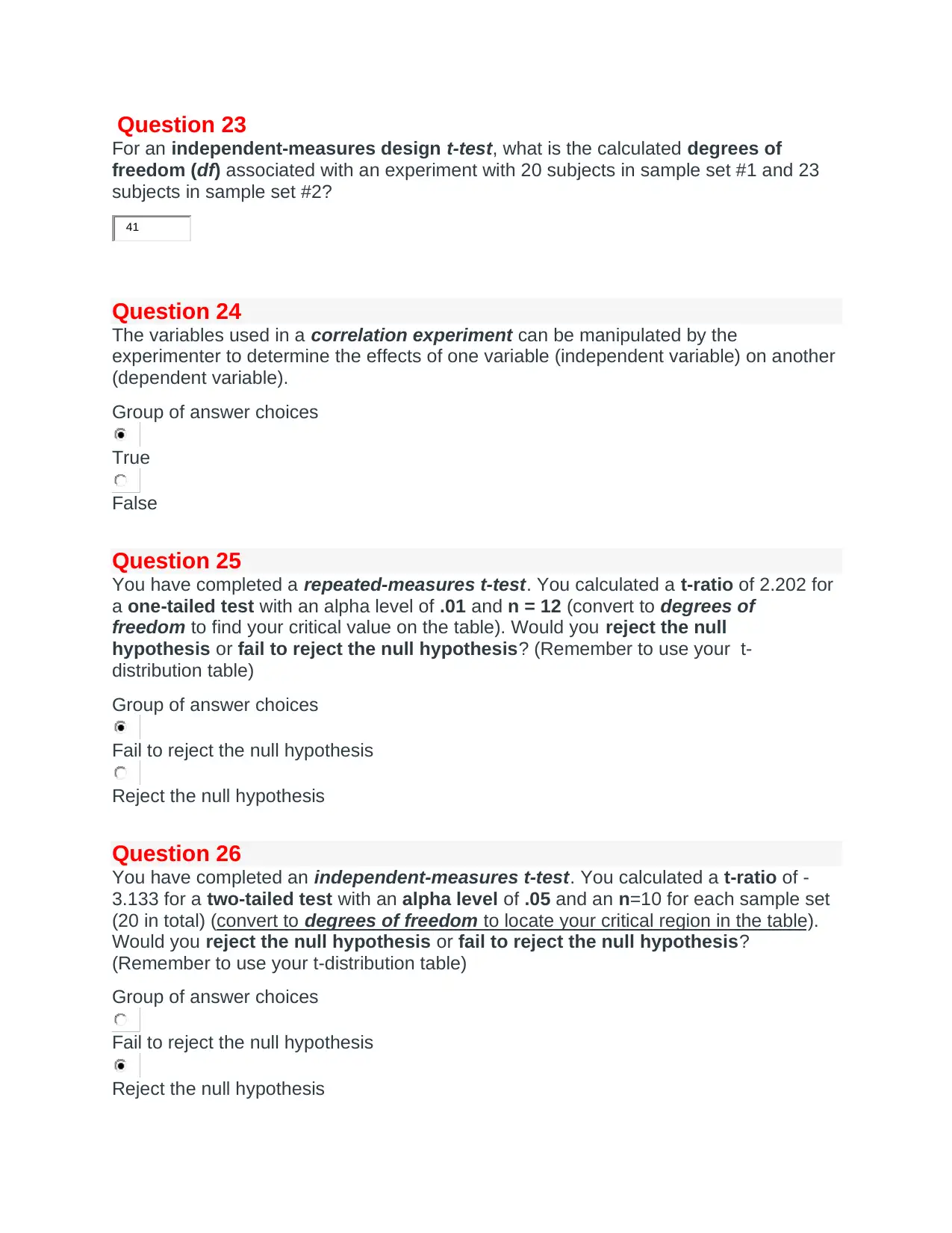
Question 23
For an independent-measures design t-test, what is the calculated degrees of
freedom (df) associated with an experiment with 20 subjects in sample set #1 and 23
subjects in sample set #2?
41
Question 24
The variables used in a correlation experiment can be manipulated by the
experimenter to determine the effects of one variable (independent variable) on another
(dependent variable).
Group of answer choices
True
False
Question 25
You have completed a repeated-measures t-test. You calculated a t-ratio of 2.202 for
a one-tailed test with an alpha level of .01 and n = 12 (convert to degrees of
freedom to find your critical value on the table). Would you reject the null
hypothesis or fail to reject the null hypothesis? (Remember to use your t-
distribution table)
Group of answer choices
Fail to reject the null hypothesis
Reject the null hypothesis
Question 26
You have completed an independent-measures t-test. You calculated a t-ratio of -
3.133 for a two-tailed test with an alpha level of .05 and an n=10 for each sample set
(20 in total) (convert to degrees of freedom to locate your critical region in the table).
Would you reject the null hypothesis or fail to reject the null hypothesis?
(Remember to use your t-distribution table)
Group of answer choices
Fail to reject the null hypothesis
Reject the null hypothesis
For an independent-measures design t-test, what is the calculated degrees of
freedom (df) associated with an experiment with 20 subjects in sample set #1 and 23
subjects in sample set #2?
41
Question 24
The variables used in a correlation experiment can be manipulated by the
experimenter to determine the effects of one variable (independent variable) on another
(dependent variable).
Group of answer choices
True
False
Question 25
You have completed a repeated-measures t-test. You calculated a t-ratio of 2.202 for
a one-tailed test with an alpha level of .01 and n = 12 (convert to degrees of
freedom to find your critical value on the table). Would you reject the null
hypothesis or fail to reject the null hypothesis? (Remember to use your t-
distribution table)
Group of answer choices
Fail to reject the null hypothesis
Reject the null hypothesis
Question 26
You have completed an independent-measures t-test. You calculated a t-ratio of -
3.133 for a two-tailed test with an alpha level of .05 and an n=10 for each sample set
(20 in total) (convert to degrees of freedom to locate your critical region in the table).
Would you reject the null hypothesis or fail to reject the null hypothesis?
(Remember to use your t-distribution table)
Group of answer choices
Fail to reject the null hypothesis
Reject the null hypothesis
Paraphrase This Document
Need a fresh take? Get an instant paraphrase of this document with our AI Paraphraser
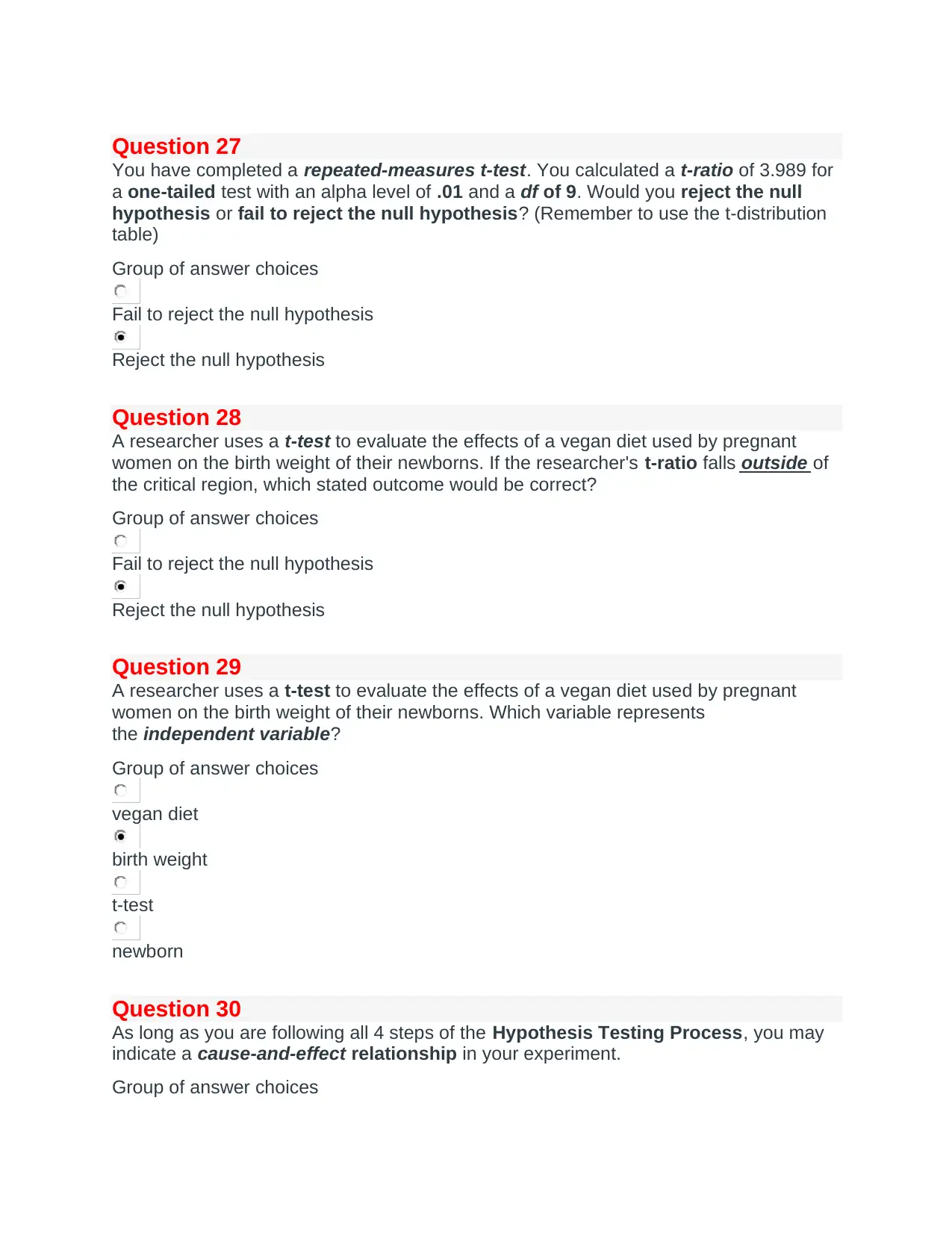
Question 27
You have completed a repeated-measures t-test. You calculated a t-ratio of 3.989 for
a one-tailed test with an alpha level of .01 and a df of 9. Would you reject the null
hypothesis or fail to reject the null hypothesis? (Remember to use the t-distribution
table)
Group of answer choices
Fail to reject the null hypothesis
Reject the null hypothesis
Question 28
A researcher uses a t-test to evaluate the effects of a vegan diet used by pregnant
women on the birth weight of their newborns. If the researcher's t-ratio falls outside of
the critical region, which stated outcome would be correct?
Group of answer choices
Fail to reject the null hypothesis
Reject the null hypothesis
Question 29
A researcher uses a t-test to evaluate the effects of a vegan diet used by pregnant
women on the birth weight of their newborns. Which variable represents
the independent variable?
Group of answer choices
vegan diet
birth weight
t-test
newborn
Question 30
As long as you are following all 4 steps of the Hypothesis Testing Process, you may
indicate a cause-and-effect relationship in your experiment.
Group of answer choices
You have completed a repeated-measures t-test. You calculated a t-ratio of 3.989 for
a one-tailed test with an alpha level of .01 and a df of 9. Would you reject the null
hypothesis or fail to reject the null hypothesis? (Remember to use the t-distribution
table)
Group of answer choices
Fail to reject the null hypothesis
Reject the null hypothesis
Question 28
A researcher uses a t-test to evaluate the effects of a vegan diet used by pregnant
women on the birth weight of their newborns. If the researcher's t-ratio falls outside of
the critical region, which stated outcome would be correct?
Group of answer choices
Fail to reject the null hypothesis
Reject the null hypothesis
Question 29
A researcher uses a t-test to evaluate the effects of a vegan diet used by pregnant
women on the birth weight of their newborns. Which variable represents
the independent variable?
Group of answer choices
vegan diet
birth weight
t-test
newborn
Question 30
As long as you are following all 4 steps of the Hypothesis Testing Process, you may
indicate a cause-and-effect relationship in your experiment.
Group of answer choices

True
False
False
⊘ This is a preview!⊘
Do you want full access?
Subscribe today to unlock all pages.

Trusted by 1+ million students worldwide
1 out of 9
Related Documents
Your All-in-One AI-Powered Toolkit for Academic Success.
+13062052269
info@desklib.com
Available 24*7 on WhatsApp / Email
![[object Object]](/_next/static/media/star-bottom.7253800d.svg)
Unlock your academic potential
Copyright © 2020–2025 A2Z Services. All Rights Reserved. Developed and managed by ZUCOL.





